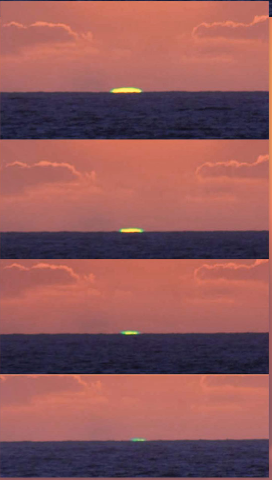OPOD - Classical Green Flash
The Classical Green Flash: A Phenomenon of Atmospheric Optics
The classical green flash is a mesmerizing optical phenomenon that occurs during sunrise or sunset. It is characterized by a fleeting, brilliant green light that appears as a sliver on the horizon. While green flashes can manifest in various forms, such as mock mirage flashes and cloud top flashes, the classical green flash is the most sought-after and captivating.
The Elusive Nature of the Classical Green Flash
Unlike other types of green flashes, the classical green flash does not require any camera equipment to observe. It can be witnessed with the naked eye, provided the atmospheric conditions are just right. Although a clear sky is often considered ideal, it is not an absolute requirement for experiencing this phenomenon.
Omens and Mirages
There are several telltale signs that precede the appearance of the classical green flash. The atmospheric conditions necessary for its formation can be observed early on. As the sun begins to descend, a second sun seems to rise from the horizon, resulting in an "omega" shape where the two suns meet. These joined and distorted images then descend with a visible lip at the sea surface.
The key to understanding the classical green flash lies in the presence of a mirage. As the sun's rays slant across temperature gradients between a warm air layer near the sea and cooler air above, they undergo refraction. This refraction causes the rays to bend upward, creating two images of the sun: an upper "normal" one and a lower inverted one that rises. The merging of these images, first at the "omega" shape (producing a red flash) and then just before they both set (resulting in the green flash), leads to a significant vertical magnification. This stretching effect allows for the separation of colors to become visible, producing the stunning green hue.
Debunking Misconceptions
Contrary to popular belief, the classical green flash is not caused by differential refraction between red and green light. The small refraction effects of ordinary atmospheric conditions are insufficient to produce the flash, and the flash does not occur precisely on the horizon. Instead, it is the presence of a mirage that creates the necessary conditions for this captivating phenomenon.
The Beauty of the Classical Green Flash
The classical green flash is a testament to the enchanting wonders of atmospheric optics. Its brief yet vibrant appearance captivates observers, leaving them in awe of the natural world's ability to create such stunning visual displays. Whether witnessed over the vast expanse of the ocean or against the backdrop of a wind-swept hillside, the classical green flash never fails to evoke a sense of wonder and appreciation for the complexities of our atmosphere.
Conclusion
The classical green flash stands as a captivating example of the beauty and intricacy of atmospheric optics. While it may be elusive and fleeting, those fortunate enough to witness this phenomenon are treated to a truly extraordinary sight. From its omens and mirage formation to its debunking of misconceptions, the classical green flash provides a fascinating glimpse into the interplay between light, temperature gradients, and atmospheric conditions. So, keep your eyes peeled during sunrise or sunset, for you may just catch a glimpse of this mesmerizing spectacle that nature graciously bestows upon us.

Classical Green Flash
A sliver of sun brilliant green on the horizon, a classical green flash. Seen by Giuseppe Pappa at Giojosa Marea, Messina, Sicily on the Tyrrhenian sea.
All images ©Giuseppe Pappa, shown with permission.

Green flashes come in different flavours. Mock mirage flashes flicker on distorted layered suns still partially above the horizon but they are rarely visible to the unaided eye and it is dangerous to stare or use binoculars. Cloud top flashes similarly give rare and evanescent glints to cameras as the sun slides behind a cloud bank. Green is sometimes even seen by cameras as the sun sets behind a wind swept hillside.
But the much sought classical flash of literature needs no camera. At its best it blazes forth a brilliant and startling emerald light as the last slice of sun is poised on the horizon. A clear sky is maybe best but it is not crucial.
There are plenty of omens. The mirage conditions essential to form the flash show up early. As the sun sinks a second sun starts to rise from the horizon. They meet in an �omega� shape. The joined and distorted images then descend with a distinct lip visible at the sea surfaces. Finally there is the flash itself.
Believe not the all too many accounts citing differential refraction between red and green light producing an upper green edge to the sun that sets last. They miss the point, ordinary refraction effects are far too small to give a flash and it is not quite on the horizon anyway. A mirage is needed. Sun rays are refracted upwards as they slant across the temperature gradients linking a warm air layer close to the sea and cooler air above. Two images form, an upper �normal� one and a lower one that is inverted and rises. Where the images merge, first at the �omega� to give a red flash and then just before they both set (green flash) there is strong vertical magnification of the images. The extreme stretching makes the otherwise small colour separation visible.

Note: this article has been automatically converted from the old site and may not appear as intended. You can find the original article here.
Reference Atmospheric Optics
If you use any of the definitions, information, or data presented on Atmospheric Optics, please copy the link or reference below to properly credit us as the reference source. Thank you!
-
<a href="https://atoptics.co.uk/blog/opod-classical-green-flash/">OPOD - Classical Green Flash</a>
-
"OPOD - Classical Green Flash". Atmospheric Optics. Accessed on November 22, 2024. https://atoptics.co.uk/blog/opod-classical-green-flash/.
-
"OPOD - Classical Green Flash". Atmospheric Optics, https://atoptics.co.uk/blog/opod-classical-green-flash/. Accessed 22 November, 2024
-
OPOD - Classical Green Flash. Atmospheric Optics. Retrieved from https://atoptics.co.uk/blog/opod-classical-green-flash/.